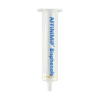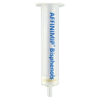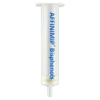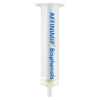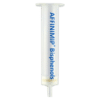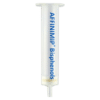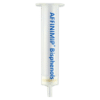Bisphenol A and other Bisphenols
Bisphenol A is an endocrine disruptor, which can mimic the body’s own hormones and may lead to negative health effects. The migration of Bisphenol A from the packaging to food is the main source of consumers’ exposure to BPA. So, the European commission has defined a specific migration limit at a maximum level of 0.6 mg of BPA/kg of food (Directive 2011/8/EU of 28 January 2011). In addition, the directive prohibits the use of BPA to manufacture infant feeding bottles.
More recently, in April 2023, in a European Food Safety Authority (EFSA) communication, a re-evaluation of the full risk assessment.
Compared to their previous assessment in 2015, EFSA’s expert Panel significantly lowered the tolerable daily intake (TDI) for BPA, the amount that can be ingested daily over a lifetime without presenting an appreciable health risk.
EFSA’s scientists established a TDI of 0.2 ng/kg of body weight per day, replacing the previous temporary level of 4 µg/kg of body weight per day.
The newly established TDI is around 20,000 times lower.
This new recommendation should have an impact on the regulations concerning the above specific migration limit for food contact materials (FCM).
The European Commission and national authorities are responsible for setting limits on the amount of a chemical that may migrate from food packaging into food. So, appropriate regulatory measures should be taken to protect consumers.
We have developed our SPE solution to clean and concentrate selectively Bisphenol A and closely related structures such as BADGE before analysis by chromatography (LC, GC…).
Discover our AFFINIMIP® SPE Bisphenols cartridge to learn more.
- Endocrine Disruptors /
- Bisphenol A and other Bisphenols
Application Note AFFINIMIP®SPE Bisphenols for the total Bisphenol A determination in human urine
Human Urine
This application note describes a method to determine TOTAL Bisphenol A in Human urine. The combination of AFFINIMIP® SPE Bisphenols and LC-MS/MS enables the determination of very low concentration of Bisphenol A in urine.
- Endocrine Disruptors /
- Bisphenol A and other Bisphenols
Application note AFFINIMIP®SPE BISPHENOLS - COLA drinks
Cola drinks
This application note describes a method to determine Bisphenol A in Cola drinks. Recovery yields higher than 90% were obtained at concentration of 5ng/mL.
- Endocrine Disruptors /
- Bisphenol A and other Bisphenols
Application Note AFFINIMIP®SPE for the analysis of Bisphenol A in Beer at low concentrations
Beer matrices
This study describes the solid phase extraction of Bisphenol A from beer at low concentrations (1 and 2µg/L) using AFFINIMIP® SPE Bisphenols. HPLC analysis was performed with a flurescence detector. The results demonstrate the efficiency of the clean-up: high recovery yield (> 90%), a good repeatability and reproducibility were obtained.
- Endocrine Disruptors /
- Bisphenol A and other Bisphenols
Application Note AFFINIMIP®SPE Bisphenols - Red and white wines
Red and white wines
The determination of very low concentration (2µg/Kg) of Bisphenol A in Red and White Wines was carried out with a fluorescent detector after AFFINIMIP®SPE Bisphenols clean-up.
- Endocrine Disruptors /
- Bisphenol A and other Bisphenols
Application note AFFINIMIP®SPE BISPHENOLS - BISPHENOL A AND BADGE IN MILK
Bisphenol A and BADGE
This application note describes a method to determine Bisphenol A and BADGE in milk from plastic food packaging.
- Endocrine Disruptors /
- Bisphenol A and other Bisphenols
Application Note AFFINIMIP®SPE Bisphenols in Powdered Infant Formula at low concentrations
Powdered Infant Formula
This application note describes the analysis of very low concentration of BPA in powdered infant formula using AFFINIMIP®SPE Bisphenols cartridge. The method is perfectly suited for the quantification of Bisphenol A at very low concentration (2µg/L and 4µg/L), even using a fluorescence detector. The simple SPE procedure ensures mean recoveries > 95% and a very low relative standard deviation.
- Endocrine Disruptors /
- Bisphenol A and other Bisphenols
Application Note AFFINIMIP®SPE for the analysis of Bisphenol A in Infant Formula at low concentrations
Liquid Infant Formula
We demonstrate in this application note that a reliable quantification of Bisphenol A in liquid infant formula using fluorescence detection is possible, even at low concentrations(1 and 2µg/L). The use of AFFINIMIP®SPE Bisphenols enables to eliminate the tedious derivatization step required by gas chromatography.
- Endocrine Disruptors /
- Bisphenol A and other Bisphenols
Application note AFFINIMIP®SPE Bisphenols in Vegetable Puree
Vegetable Puree for Infants
This application note describes the analysis of very low concentration (3µg/kg and 24µg/kg) of BPA in vegetable puree for infant contained in a plastic food packaging using AFFINIMIP®SPE Bisphenols cartridge.
- Endocrine Disruptors /
- Bisphenol A and other Bisphenols
Application Note AFFINIMIP®SPE for the analysis of Bisphenol A from Canned Foods at low concentrations
Canned Foods
The tests were performed in canned peas and carrots and canned tuna and salmon. The results demonstrate the efficiency of the clean-up with fluorescence detection: high recovery yield (> 95%), a good repeatability and reproducibility were obtained in all the matrices.This method is also perfectly suitable for clean-up before GC-MS/MS or LC-MS/MS.
In this study, the potential endocrine and genotoxic effects of bisphenol A and bisphenol S in juvenile brown trout (Salmo trutta) were investigated.
The effects of the exposure to these compounds on the thyroid hormone levels and the estrogenic disrupting marker vitellogenin were evaluated, along with the genotoxic markers micronucleated cells and erythrocyte nuclear abnormalities.
Bisphenols A and S bioaccumulation were analyzed from fish liver tissue after a clean-up with AFFINIMIP® SPE Bisphenols.
Frenzilli G, Martorell-Ribera J, Bernardeschi M, Scarcelli V, Jönsson E, Diano N, Moggio M, Guidi P, Sturve J and Asker N; Bisphenol A and Bisphenol S Induce Endocrine and Chromosomal Alterations in Brown Trout. Front. Endocrinol. 12:645519. (2021) ; OPEN ACCESS – NEW!
In this study, the simplification and optimization of a method of determination of the free (aglycone) BPA in foodstuffs is proposed for sheep muscle tissue, kidney and liver. A single MISPE purification step is carried out prior to HPLC-FLD analysis. The recovery rates and RSD values over a concentration range of 1‒10 µg/kg were in the range of 67‒86% and 3‒34%, respectively. LOD values were 0.5‒1 μg/kg and LOQ values were 1 μg/kg. Linearity over this range of concentration was verified.
Vesna Cerkvenik-Flajs , Sabina Sturm , A rapid analysis of bisphenol A using MISPE coupled with HPLC-FLD in tissues of food-producing animals, MethodsX (2021); OPEN ACCESS – NEW!
This publication shows the validation of an accurate and very sensitive method for the simultaneously quantification of BPA, 17_-Estradiol and testosterone in two target tissues (testis and visceral fat mass).
The protocol requires a cleanup with AFFINIMIP®SPE columns prior to LC-MS/MS quantification. The use of these columns allows obtaining high percentages of process efficiency (68.0–83.3% for testicular tissue; 63.7–70.7% for visceral fat mass). Good repeatability and reproducibility was observed and the linearity verified in both tissues. The validated method can be efficiently applied for direct biological monitoring in testis and visceral fat mass from mice exposed to BPA. The quantification of compounds in a single assay could be achieved without a loss of sensitivity.
Errico, S.; Chioccarelli, T.; Moggio, M.; Diano, N.; Cobellis, G. A New LC-MS/MS Method for Simultaneous and Quantitative Detection of Bisphenol-A and Steroids in Target Tissues: A Power Tool to Characterize the Interference of Bisphenol-A Exposure on Steroid Levels. Molecules 2020, 25, 48. OPEN ACCESS.
An innovative complementary approach using a liquid chromatographic-mass spectrometer method and infrared spectroscopy is proposed for measuring internal biological exposure to dangerous chemical contaminants and for monitoring biochemical changes in target organs. The proposed methodologies were validated and applied in the case of rats exposed to low-doses of Bisphenol A (BPA). A liquid chromatographic method coupled to a tandem mass spectrometer was used in order to measure BPA concentration in rat livers after a clean up with AFFINIMIP®SPE BISPHENOLS.
Sonia Errico, Marianna Portaccio, Carla Nicolucci, Rosaria Meccariello, Rosanna Chianese, Marika Scafuro, Maria Lepore, Nadia Diano, A novel experimental approach for liver analysis in rats exposed to Bisphenol A by means of LC-mass spectrometry and infrared spectroscopy, Journal of Pharmaceutical and Biomedical Analysis, Volume 165, 2019, Pages 207-212.
An analytical procedure has been introduced to enable a study of the excretion of free bisphenol A (BPA), total BPA and its main metabolite bisphenol A glucuronide (BPA–GLUC). 100 lg/kg b. w. BPA was administered daily to one sheep for 5 days with consecutive urine and feces samples being taken, BPA and total BPA were determined in samples using HPLC with fluorescence detection.
Determination of free and total bisphenol A in the urine and feces of orally and subcutaneously dosed sheep by high-performance liquid chromatography with fluorescence detection, Sabina Šturm, Andrej Škibin, Milan Pogačnik & Vesna Cerkvenik-Flajs (2020), Journal of Environmental Science and Health, Part B.
The aim of the study was to preliminarily evaluate the bisphenol A exposure and disposition in sheep milk after repeated dietary and subcutaneous administration of a relatively low dose (100 μg/kg of b. w./day) of bisphenol A to a sheep. A toxicokinetic model was developed on the basis of the analysis of blood plasma and milk cleaned-up with AFFINIMIP SPE Bisphenols.
Preliminary toxicokinetic study of BPA in lactating dairy sheep after repeated dietary and subcutaneous administration. Šturm, S., Grabnar, I., Škibin, A. et al. Sci Rep 10, 6498 (2020).
The effect of BPA and silybin, alone or in combination, on proliferation, oxidative stress and steroid metabolism in HepG2 grown in high glucose concentration medium (H-HepG2) were investigated. Steroids extraction from cell culture medium were done with AFFINIMIP® SPE Bisphenols.
Ameliorative effect of Silybin on bisphenol A induced oxidative stress, cell proliferation and steroid hormones oxidation in HepG2 cell cultures. Lama, S., Vanacore, D., Diano, N. et al. Sci Rep 9, 3228 (2019).
An analytical method was developped for the determination of BPA in sea water, algaes, sediments, tissue mussels and shells from farms and open sea. With this method combining AFFINIMIP® SPE Bisphenols clean-up and fluorescence detection, a limit of detection of 0.03µg/kg, 0.01µg/kg, 0.003 µg/kg and 0.4µg/kg was respectively determined for mussels’ tissue, shells and sediments, seawater and algae.
Analysis and Occurrence of Bisphenol A in Mediterranean Mussels (Mytilus galloprovincialis) Sampled from the Slovenian Coastal Waters of the North Adriatic Sea, Cerkvenik-Flajs, V., Fonda, I. & Gombač, M. Bull Environ Contam Toxicol (2018).
A multi-residue method for determination of BPA, 4 – octylphenol (4 – OP), 4 – tert – octylphenol (4 -t-OP), 4 – nonylphenol (4 – NP) and tert – nonylphenol ( t – NP) has been developed and validated in feed and fish muscle by purification with AFFINIMIP® SPE Bisphenols and LC/ESI -MS/MS analysis.
& 6. Determination of bisphenols and alkylphenols in food, feed and biological matrices, P. Gallo, I. Di Marco Pisciottano and D. G. Mita, in Endocrine Disruptors and their Effect on Environment and Human Health, 2018 :143 – 157 ISBN: 978 – 81- 308 – 0576 – 4 Editor: Damiano Gustavo Mita , Research Signpost Trivandrum Kerala, India.
Bisphenol A (BPA) levels in urine and plasma of non-alcoholic fatty liver disease (NAFLD) patients were analysed to evaluate the correspondence between these levels and the severity of the disease. AFFINIMIP SPE Bisphenols is used in the clean-up procedure of plasma and after deglucuronisation of BPA in urine.
Role of bisphenol A as environmental factor in the promotion of non‐alcoholic fatty liver disease: in vitro and clinical study, Dallio M, Masarone M, Errico S, et al., Aliment Pharmacol Ther. 2018;00:1–12.
Bisphenol A, 4-t-Octylphenol and 4-Nonylphenol in fish tissus and sediments were analyzed by HPLC – Fluorescence. The method was validated with a clean up with AFFINIMIP®SPE BISPHENOLS with respective LOD of 0.1, 0.06 and 0.08ng/mL and a linearity evaluated between 0.1 and 200ng/mL.
Analysis and occurrence of some phenol endocrine disruptors in two marine sites of the northern coast of Sicily (Italy), S. Errico, C. Nicolucci, M. Migliaccio, V. Micale, D. G. Mita, N. Diano, Marine Pollution, 120 (1-2), 68 – 74, 2017.
A LC/ESI-MS/MS method for unconjugated BPA levels in human plasma is proposed. The method was in-house validated, and is sensitive, accurate and precise. The linearity of the detector response was verified in human plasma over the concentration range 0.100-200 ng mL-1. The detection limit was 0.03 ng mL-1 and the quantification limit was 0.100 ng mL-1. The analytical features of the proposed in-house validated method were satisfactory: precision was Human plasma samples from individuals affected by liver disease has been analyzed. An association between liver health status and BPA exposure has been observed.
Human exposure to Bisphenol A and liver health status: Quantification of Urinary and Circulating levels by LC-MS/MS, C. Nicolucci, S. Errico, A. Federico, M. Dallio, C. Loguercio, N. Diano, Journal of Pharmaceutical and Biomedical Analysis, 140, 105-112, 2017.
Juvenile seabream were fed for 21 days a diet enriched with different combinations of pollutants, nonylphenol (NP), tert-octylphenol (t-OP) and bisphenol A (BPA) to study the effect on the lipid metabolism. These contaminants were extracted with AFFINIMIP®SPE BISPHENOLS from muscle fish. LC/ESI-QTRAP-MS/MS analysis showed the ability of NP to accumulate in the muscle of fish.
Dietary administration of EDC mixtures: A focus on fish lipid metabolism, O. Carnevali, V. Notarstefano, I. Olivotto, M. Graziano, P. Gallo, I. Di Marco Pisciottano, L. Vaccari, A. Mandich, E. Giorgini, F. Maradonna, Aquatic Toxicology 185, 95 – 104, 2017.
A new method for simultaneous determination of five bisphenols in canned energy drinks by UPLC with fluorescence detection, after clean up with AFFINIMIP®SPE Bisphenols has been validated at two concentration levels, calculating trueness, repeatability and withinlaboratory reproducibility, specificity, linearity of detector response, the limits of quantifications and the limits of detection for each bisphenol. The method is specific, reliable and very sensitive, allowing for determination of bisphenol F diglycidyl ether (BFDGE), bisphenol A (BPA), bisphenol B (BPB), bisphenol F (BPF) and bisphenol A diglycidyl ether (BADGE) down to 0.50 ng/mL.
Determination of BPA, BPB, BPF, BADGE and BFDGE in canned energy drinks by molecularly imprinted polymer cleaning up and UPLC with fluorescence detection, P. Gallo, I. Di Marco Pisciottano, F. Esposito, E. Fasano, G. Scognamiglio, G. Damiano Mita, T. Cirillo, Food Chemistry, 220, 406-412, 2017.
This article describes the metabolic effects induced by feed contaminated with nonylphenol (NP), 4‐tert‐octylphenol (t‐OP) or bisphenol A (BPA) in juvenile sea bream liver. For this study, Nonylphenol (NP), 4‐tert‐Octylphenol (t‐OP) and Bisphenol A (BPA) are extracted with AFFINIMIP®SPE BISPHENOLS.
Xenobiotic-contaminated diets affect hepatic lipid metabolism: implications for liver steatosis in Sparus aurata juveniles. Maradonna, F., Nozzi, V., Santangeli, S., Traversi, I., Gallo, P., Fattore, E., Mita, D.G., Mandich, A., Carnevali, O. Aquatic Toxicology, 257-264 ,2015.
This article describes an accurate and sensitive method of determination of 18 Bisphenol analogues in human breast milk by GC-MS/MS. By using AFFINIMIP®SPE BISPHENOLS in the sample preparation protocol, LABERCA analyzes FREE and TOTAL bisphenol analogues with recovery yields higher than 90% for all analogues.
List of the 18 Bisphenol analogues analyzed: Bisphenol B (BPB), bisphenol AP (BPAP), bisphenol AF (BPAF), bisphenol BP (BPBP), bisphenol C (BPC), bisphenol Cl2 (BPCl2), bisphenol E (BPE), bisphenol PH (BPPH), bisphenol S (BPS), bisphenol F (BPF), [4,4′-dihydroxydiphenyl ether (DHDPE), bisphenol FL (BPFL), bisphenol Z (BPZ), biphenyl-4,4′-diol (BP4,4′), bisphenol M (BPM), bisphenol P (BPP), bis-2(hydroxyphenyl)methane (BIS2) and biphenyl-2,2′-diol (BP2,2′).
Determination of bisphenol A and related substitutes/analogues in human breast milk using gas chromatography-tandem mass spectrometry, Y. Deceuninck, E. Bichon, P. Marchand, C.-Y. Boquien, A. Legrand, C. Boscher, J. P. Antignac, B. Le Bizec, Anal. and Bioanal. Chem., 407 (9), 2485-2497, 2015.
A developmental hepatotoxicity study of dietary bisphenol A in Sparus aurata juveniles, F. Maradonna, V. Nozzi, L. Dalla Valle, I. Traversi, G. Gioacchini, F. Benato, E. Colletti, P. Gallo, I. Di Marco Pisciottano, D. G. Mita, G. Hardiman, A. Mandich, O. Carnevali, Comparative Biochemistry and Physiology, Part C 166, 1-13, 2014.
This article describes the determination of 7 Bisphenol analogues (BPS, BPF, BPA, BPB, bisphenol AF (BPAF), tetrachlorobisphenol A (TCBPA) and TBBPA) in beverages and canned foods samples based on AFFINIMIP® SPE BISPHENOLS before an analysis by LC-MS/MS. These cartridges demonstrating a high selectivity for these analytes, this method was used to analyse real samples that were collected from a supermarket in Beijing.
Molecularly imprinted solid-phase extraction for the selective extraction of bisphenol analogues in beverages and canned food, Yunjia Yang, Jianlong Yu, Jie Yin, Bing Shao, Jing Zhang, J. Agric. Food Chem., 62 (46), 11130-11137 (2014).
A detailed description of the extraction of Bisphenol A from a very broad range of solid and liquid food from LABERCA:
Development and validation of a specific and sensitive gas chromatography tandem mass spectrometry method for the determination of bisphenol A residues in a large set of food items, Y. Deceuninck, E. Bichon, S. Durand, N. Bemrah, Z. Zendong, M.L. Morvan, P. Marchand, G. Dervilly-Pinel J.P., Journal of Chromatography A, 1362, 241-249 (2014).
The survey results are published by ANSES, the French Health Agency: Assessment of dietary exposure to bisphenol A in the French population with a special focus on risk characterisation for pregnant French women, Nawel Bemrah, Julien Jean, Gilles Rivière, Moez Sanaa, Stéphane Leconte, Morgane Bachelot, Yoann Deceuninck, Bruno Le Bizec, Xavier Dauchy, Alain-Claude Roudot, Valérie Camel, Konrad Grob, Cyril Feidt, Nicole Picard-Hagen, Pierre-Marie Badot, Franck Foures, Jean-Charles Leblanc, Food and Chemical Toxicology 72 (2014) 90-97.
- A high selective and sensitive liquid chromatography-tandem mass spectrometry method for quantization of BPA urinary levels in children, C. Nicolucci, S. Rossi, C. Menale, E. Giudice, P. Miraglia del Giudice, L. Perrone, P. Gallo, D. Mita, N. Diano, Analytical and Bioanalytical Chemistry, 1618-2642, 2013. (use of glass cartridges)
- French Health Agency reports on Health risks assessment of BPA
A new report of the French Health Agency (ANSES) on assessment of the health risks associated with bisphenol A (BPA) was published on 9 April 2013. Quantitative analysis of Bisphenol A in all liquid or solid food matrices were carried out by using AFFINIMIP® SPE Bisphenols (Analyses carried out by LABERCA and described in Annex 12 of Annexes of the report p132 (in french) and summary of the study).
Perfect clean-up using selective solid phase extraction of Bisphenol A based on molecularly imprinted polymers with LC/Fluorescence detection at low concentration, D.Derrien, M. Mulet, B. Chevalier, F. Alix, C.Pérollier, O.Lépine, K.Naraghi, S. Bayoudh, presented at HTSP-2, Second International Symposium on Hyphenated Techniques for Sample Preparation at Bruges, Belgium, January 31st – February 1st 2012.
Utilisation de la spectrométrie de masse pour le dosage du Bisphénol A dans les matrices alimentaires, Y. DECEUNINCK, Z. ZENDONG, E. BICHON, J.-P. ANTIGNAC, B. LE BIZEC.
This poster was presented at SMAP 2011, Avignon, France, 19-22 sept. 2011by the French reference laboratory on residues and contaminants in food (LABERCA).
